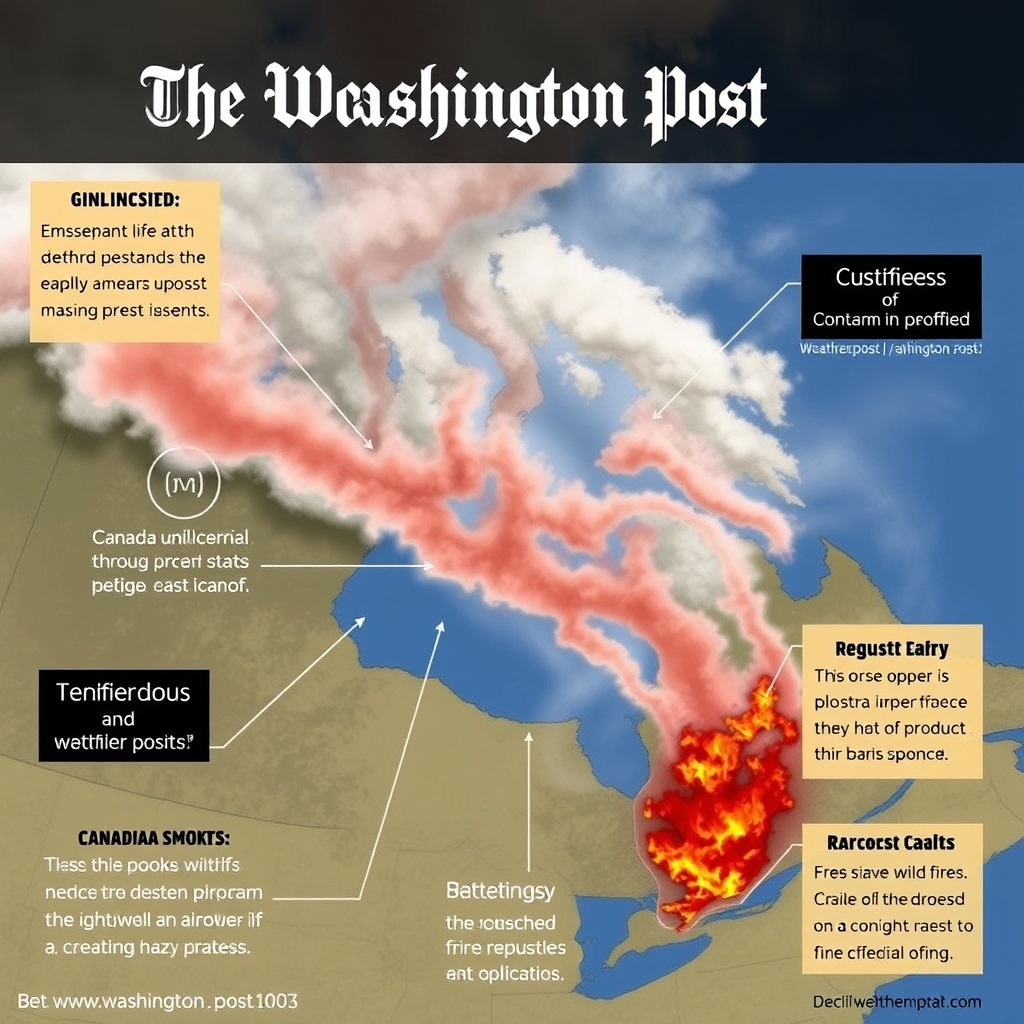Introduction
The recent surge in Canadian wildfires has sent dense smoke blowing into the United States, affecting over two dozen states and reducing air quality. The smoke, originating from Manitoba, Canada, is expected to persist through Saturday, casting a hazy shadow over the skies of the affected regions. This phenomenon is not only a nuisance but also a significant health concern, particularly for individuals with pre-existing respiratory conditions. In this article, we will delve into the causes and effects of the Canadian wildfires, the impact of the smoke on the United States, and the measures being taken to mitigate the situation.
Causes and Effects of Canadian Wildfires
The Canadian wildfires, which have been raging for several weeks, are attributed to a combination of factors, including drought, high temperatures, and strong winds. The province of Manitoba has been particularly affected, with numerous fires burning out of control. The smoke from these fires has been carried by winds into the United States, affecting states such as Michigan, New York, and Pennsylvania. The effects of the smoke are far-reaching, with reduced air quality, hazy skies, and increased health risks being the most significant concerns.
According to the Air Quality Index (AQI), the affected regions have experienced a significant decline in air quality, with some areas reaching hazardous levels. The AQI is a measure of the level of air pollution in a given area, with higher values indicating poorer air quality. The smoke from the Canadian wildfires has pushed the AQI into the red zone, indicating a high level of health concern. For example, in Michigan, the AQI has reached levels of over 150, which is considered unhealthy for sensitive groups. This has prompted health officials to issue warnings and advisories, urging individuals to take precautions to minimize their exposure to the smoke.
Impact on the United States
The impact of the Canadian wildfires on the United States has been significant, with over two dozen states affected by the smoke. The smoke has reduced air quality, created hazy skies, and increased health risks. The affected states have experienced a range of impacts, from mild to severe, depending on the proximity to the source of the smoke and the prevailing wind patterns. For instance, states in the Midwest, such as Michigan and Illinois, have been heavily affected, with reduced visibility and poor air quality being the primary concerns.
In addition to the health risks, the smoke has also had an economic impact, particularly on outdoor activities such as tourism and agriculture. The reduced visibility and poor air quality have made it difficult for tourists to enjoy outdoor activities, such as hiking and camping, while farmers have had to contend with reduced crop yields and lower quality produce. According to a study by the National Oceanic and Atmospheric Administration (NOAA), the economic impact of wildfires can be significant, with estimated losses ranging from $10 billion to $20 billion per year.
Mitigation and Response Efforts
To mitigate the effects of the Canadian wildfires, authorities in both Canada and the United States have been working together to respond to the situation. In Canada, firefighters have been battling the blazes, with support from the military and other emergency services. In the United States, health officials have been issuing warnings and advisories, urging individuals to take precautions to minimize their exposure to the smoke.
Some of the measures being taken to mitigate the situation include:
- Air quality monitoring: Authorities are closely monitoring air quality in the affected regions, providing real-time updates and warnings to the public.
- Smoke advisories: Health officials are issuing smoke advisories, urging individuals to stay indoors, avoid strenuous activities, and wear masks when outdoors.
- Firefighting efforts: Firefighters are working to contain and extinguish the blazes, with support from the military and other emergency services.
- Economic support: Governments are providing economic support to affected communities, including financial assistance and resources for farmers and small businesses.
For example, in Michigan, the state government has established a wildfire response team, which includes representatives from the Michigan Department of Natural Resources, the Michigan Department of Health and Human Services, and the Michigan State Police. The team is working to coordinate the response efforts, provide updates to the public, and offer support to affected communities.
Conclusion
The dense smoke from Canadian wildfires blowing into the United States is a significant concern, with far-reaching impacts on air quality, health, and the economy. The causes of the wildfires are complex, involving a combination of factors such as drought, high temperatures, and strong winds. The effects of the smoke are being felt across over two dozen states, with reduced air quality, hazy skies, and increased health risks being the primary concerns.
As the situation continues to unfold, it is essential that authorities in both Canada and the United States work together to respond to the crisis. This includes providing real-time updates and warnings to the public, supporting firefighting efforts, and offering economic support to affected communities. By working together, we can mitigate the impacts of the Canadian wildfires and minimize the risks to public health and the environment.
In the long term, it is crucial that we address the root causes of the wildfires, including climate change, drought, and land management practices. This requires a coordinated effort from governments, communities, and individuals to reduce our carbon footprint, promote sustainable land use practices, and support wildfire prevention and mitigation efforts. By taking a proactive and collaborative approach, we can reduce the risk of wildfires and minimize their impacts on our communities and the environment.


Leave a comment